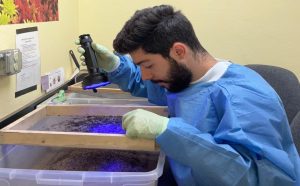Researchers in the Wisely lab in the UF|IFAS Department of Wildlife Ecology and Conservation are on the hunt for an elusive soft tick in an effort to determine its ecology and potential for disease spread in Florida.
African Swine Fever Virus (ASFV)

In recent years, pig farms across the globe have been combating a fatal disease caused by African Swine Fever Virus. Originally from Africa, this virus has spread throughout Eurasia as a result of the international pork trade. Nowadays, the virus is established in their wild boar populations, and outbreaks in domestic pigs have occurred in Eastern Europe, China, and Southeast Asia. In 2021, the virus was detected in the Caribbean island of Hispaniola, and USDA is proactively preparing for a potential introduction to the United States. At the Wisely Lab, our role in this preparation is to better our understanding of the potential vectors for this virus: mammalian soft ticks (Ornithodoros turicata).
Why research soft ticks?
We know very little about these elusive ticks. As a result, one of our first efforts in this project was accumulating all the published information on these alien-looking arachnids. We found reports of these soft ticks being in Florida from as far back as 1895. Besides that, the 1900s produced only a handful of sporadic reports. As we prepared to create a distribution map for this species across the state, we weren’t even sure if they are still found here. Nonetheless, we knew the importance of this work and the importance of understanding the potential risk of ASFV.
But once we had a relative distribution, how would we collect our samples from the field? Fortunately, we came across a paper from 1989 by an entomologist at the University of Florida describing just that. They used a method of vacuuming the debris in a gopher tortoise burrow to collect the soft ticks and CO2 traps to coax them out. Their success with these methods led us to adopt the same collection techniques in our own quest for these ticks.
Preparations for the fieldwork
Now that we knew where and how to collect them, we needed to focus on our goals. With the help of the U.S. Department of Agriculture, we developed a research project with three main objectives:
- Develop an effective standardized method for the survey and collection of these soft ticks from gopher tortoise burrows.
- Create a model that showcases the population of soft ticks across the state of Florida.
- Determine the relationship between these soft ticks and wild boars through bloodmeal analysis.

For our first objective, we will visit Ordway Swisher Biological Station (OSBS) to collect samples from burrows using different collection methods to assess efficiency. Once we determine the most effective way of collecting the ticks from the burrows, we will scale it to the state-level.
For our second objective, we will use environmental conditions recorded at each site and the number of soft ticks collected to create a high-resolution model of where these vectors are found throughout Florida.
For our third objective, we will use a little molecular magic. Surprisingly, traces of blood from a host can be found inside the soft ticks for a year after they last fed on them. Using this to our advantage, we can extract DNA from the soft tick’s digestive tract and determine whether they consistently feed on wild boars.
Preliminary findings from Ordway-Swisher
At OSBS, we were able to identify and sample 32 burrows for soft ticks. To accomplish our first objective, we attempted to collect ticks using a burrow vacuum and a CO2 trap made of dry ice. We found that the burrow vacuuming method was much more successful in collecting soft ticks. After repeated sampling at burrows that were positive for soft ticks, we found that this method detected them 74.6% of the time. Contrarily, our dry ice method did not collect any ticks.

After deciding to use the vacuum method, we needed to develop a way of processing the sample bags that were taken from the burrow. The first method we tried consisted of manually separating the debris from the sand and searching for soft ticks. This method took over an hour for one sample bag and had a detection rate of only 53%. In an attempt to improve our efficiency, we started using sieves of different sizes to separate the debris and ticks from the sand. This method improved our average time to 30 minutes per bag and our detection rate to 80%. By the end of February, we had collected and identified 131 soft ticks from Ordway Swisher.
Currently, we continue collect from different sites across Florida and sort through our samples. Stay tuned for our results!
About the author:
Nicholas Canino is an undergraduate student at the University of Florida majoring in wildlife ecology and conservation and minoring in leadership. He is currently doing research under Dr. Samantha Wisely as part of a combined bachelor’s/master’s degree. He is the president of the student chapter of the Wildlife Disease Association and also practices Cuong Nhu mixed martial arts. His interests lie primarily in wildlife disease and One Health, and his goal is to become a wildlife veterinarian who studies infectious diseases that impact wildlife, domestic animal, and human health. He aspires to attend veterinary school to further his understanding of animal health and create a lasting impact in the field of wildlife veterinary medicine.
For more information on African Swine Fever Virus, check out these links:
USDA APHIS – African Swine Fever Virus
World Organization for Animal Health (WOAH) – African Swine Fever
 0
0
